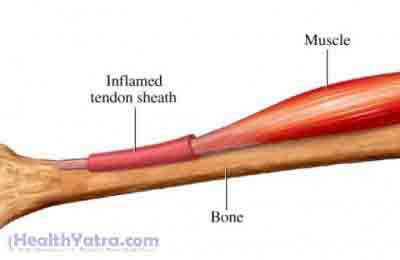Definition
Tendons are the cords that connect bones to muscles in the body. They are covered by a sleeve-like tissue. Tenosynovitis is an inflammation of this sleeve. It occurs most often in the hand, wrist, or foot.

Causes
Most cases of tenosynovitis are caused by one of the following:
- Injury
- Infection
- Strain
- Repetitive motions such as those used for:
- Computer operation
- Assembly line work
- Cash register operation
- Sports that involve repetitive actions
- Sewing
- Playing musical instruments
Risk Factors
Factors that may increase your risk of tenosynovitis include:
- Repetitive actions with your hand, wrist, or foot during work or play
- Diseases that cause inflammation such as gout and rheumatoid arthritis
Symptoms
Tenosynovitis may cause:
- Joint pain
- Joint stiffness
- Joint swelling
- Difficulty moving a joint
- Redness along the length of the tendon
Tenosynovitis is common in the tendons of the thumb. This is called de Quervain’s tenosynovitis. It causes pain and stiffness in the thumb side of the wrist.
The wrists, hands, and feet are also commonly affected. Tenosynovitis that affects tendons of the fingers can also make the finger stick in a bent position.
Diagnosis
Your doctor will ask about your symptoms and medical history. A physical exam will be done. It will include an assessment of the joint.
A blood test may also be done. Your doctor will use this to look for signs of bacterial infection or other conditions such as rheumatoid arthritis. Your doctor may refer you to a hand specialist.
Treatment
Talk with your doctor about the best treatment plan for you. The goals of treatment is to reduce swelling and pain and to allow the tendon to move freely. Treatment options include the following:
Rest
Resting the involved joint is often the best treatment for tenosynovitis. A brace or splint may be used to help you rest the joint. Rest may be combined with basic stretching and strengthening exercises.
Ice and Heat
Applying ice or heat to the area may decrease pain and swelling. Start with ice, especially soon after the injury. If ice is not helpful try heat.
Medications
Several medications are used to treat tenosynovitis. These include:
- Nonsteroidal anti-inflammatory drugs (NSAIDs) to help reduce inflammation and pain
- Topical pain medicines, such as creams and patches, that are applied to the skin
- Corticosteroids—injected into the sheath
- Antibiotics—if tenosynovitis was caused by a bacterial infection
Surgery
Surgery may be used for severe tenosynovitis. The surgery will release the tendon and allow it to move freely.
Prevention
To prevent tenosynovitis, avoid overuse of your tendons. Take the following steps if you have a job or hobby that involves repetitive motions of the hand, wrist, or foot:
- Adjust your workspace to minimize the strain on your joints
- Alternate activities when possible
- Take breaks throughout the day
- Exercise regularly
